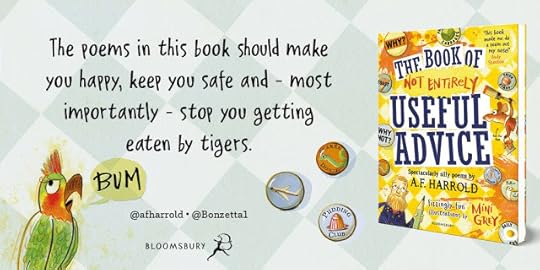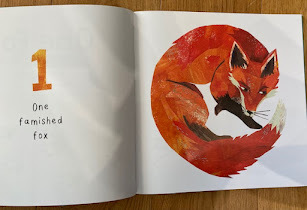Moira Butterfield's Blog, page 13
February 13, 2022
How to Promote and Celebrate Your Book with a Global Theme Day!
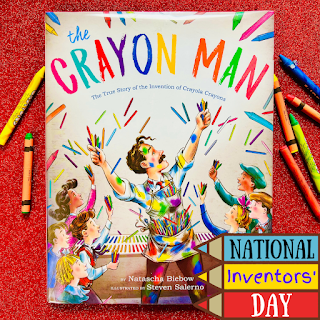
Last week on Thursday, 11 February it was National Inventors' Day.
Who knew? The reason I found out is because Eileen, an Emmy Award-winner, professional ham and YouTuber at KidTime Storytime, contacted me to ask if she could do a new read-aloud of my book THE CRAYON MAN in her signature style with . . . puppets!
When I saw her videos, I couldn't resist. They are hilarious!
Since the book's publication, National Crayon Day on 31 March has been a great hook to promote it, but this got me wondering: what other 'days' are there even out there? As an experiment, I decided to investigate what occasions fellow Picture Book Denners could use to get the word out about their latest or upcoming picture books. How can we engage with new, unexpected audiences for our writing and illustrating through this kind of lateral thinking?
Of course, in true nonfiction writer style, I soon got sucked down the rabbit hole and began imagining all kinds of new books I could write based on some of these cool themes . . .
There is no end to how creative you can be! I mean . . . 'Don't Cry Over Spilled Milk Day'? 'National Make a Friend Day . . ', 'Cow Appreciation Day', and even 'National Lollipop Day'.
Celebrations are an important part of most cultures' yearly calendars.
 We All Celebrate! by Chitra Soundar and Jenny Bloomfield
We All Celebrate! by Chitra Soundar and Jenny Bloomfield
In their book, We All Celebrate!, Jenny Bloomfield and Chitra Soundar highlight celebrations from around the world grouped by season. Filled with colour, joy and new customs and traditions for young readers to learn about and discover, it is easy to engage with each one on its featured celebration day. The all-encompassing theme inspires and encourages young readers to connect with cultural holidays around the world.
Celebrate it also on World Day for Cultural Diversity on 21 May.
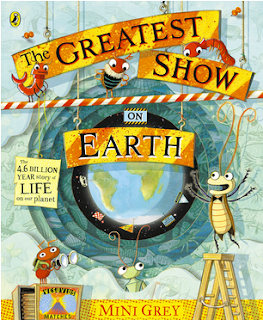 The Greatest Show on Earth by Mini Grey
The Greatest Show on Earth by Mini Grey<font size="4"><font size="3"><span style="font-family: trebuchet;">@font-face {font-family:"MS 明朝"; mso-font-charset:78; mso-generic-font-family:auto; mso-font-pitch:variable; mso-font-signature:-536870145 1791491579 18 0 131231 0;}@font-face {font-family:"Cambria Math"; panose-1:2 4 5 3 5 4 6 3 2 4; mso-font-charset:0; mso-generic-font-family:auto; mso-font-pitch:variable; mso-font-signature:-536870145 1107305727 0 0 415 0;}p.MsoNormal, li.MsoNormal, div.MsoNormal {mso-style-unhide:no; mso-style-qformat:yes; mso-style-parent:""; margin:0cm; margin-bottom:.0001pt; mso-pagination:widow-orphan; font-size:12.0pt; font-family:"Times New Roman"; mso-fareast-font-family:"MS 明朝"; mso-fareast-theme-font:minor-fareast; mso-ansi-language:EN-US;}.MsoChpDefault {mso-style-type:export-only; mso-default-props:yes; font-size:10.0pt; mso-ansi-font-size:10.0pt; mso-bidi-font-size:10.0pt; mso-fareast-font-family:"MS 明朝"; mso-fareast-theme-font:minor-fareast; mso-fareast-language:JA;}div.WordSection1 {page:WordSectio</span></font></font>
The Greatest Show on Earth by Mini Grey, which will be published in April, raises the curtain on the 4.6 million year story of Planet Earth. This sumptuous feast of a book is narrated by a friendly troop of insects who put on the show of the evolution of life on Earth – a whistle-stop tour from the birth of Earth, to the age of bacteria, the era of dinosaurs . . . to present day.
Celebrate it on Earth Day on 22 April.
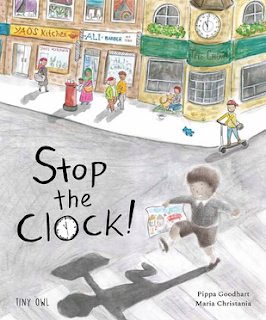 Stop the Clock! by Pippa Goodhart and Maria Christania
Stop the Clock! by Pippa Goodhart and Maria Christania
Stop the Clock! by Pippa Goodhart and Maria Christania, also published in April, tells the story of a boy who stops the clocks and goes back in time to revisit a very busy and rushed journey to school. This poignant story reminds us to slow down, take a breath and notice the small details in our busy everyday lives, and even to take time to paint them.
Celebrate it on World Sauntering Day on 19 June.
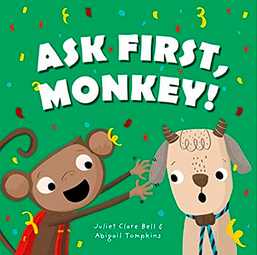 Ask First, Monkey! by Julie Clare Bell and Abigail Tompkins
Ask First, Monkey! by Julie Clare Bell and Abigail Tompkins
In Ask First, Monkey!, illustrated by Abigail Tompkins, Juliet Clare Bell tackles an important subject through story. Monkey is the best tickler in the world, ever; even his mum says so. And there's nothing he loves more than tickling ALL his friends at playtime! But what happens if some of his friends don't want to be tickled? This humorous picture book shows young children what consent is, how to consider others' feelings with respect and why it's so important. It empowers young readers to realize that a reason for 'no' is never needed - it just needs to be respected.
Celebrate it on International Day of Consent on 30 November.
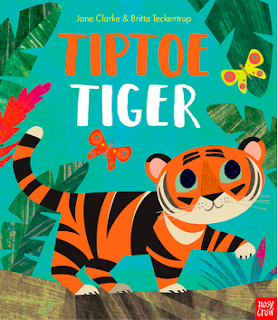 Tiptoe Tiger by Jane Clarke and Britta Teckentrup
Tiptoe Tiger by Jane Clarke and Britta TeckentrupFor every imaginative child still bouncing off the walls at the end of the day, Tiptoe Tiger by Jane Clarke and Britta Teckentrup is the perfect bedtime antidote. The interactive storytelling invites children to tiptoe round the jungle like the little tiger cub – or else scare away the beautiful butterflies and hooting owls – and to watch out for Snappy Crocodile! When at last it's bedtime, sleepy eyes will already be closing, whispering 'Night, night', just like Tiptoe Tiger.
Celebrate it on Pyjamarama Day on 13 May to promote bedtime stories for all, or even on International Tiger Day on 29 July.
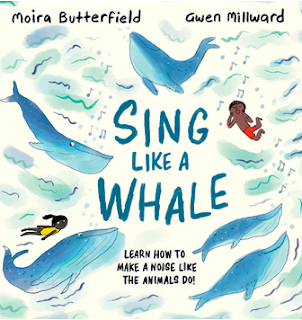 Sing Like a Whale by Moira Butterfield and Gwen Millward
Sing Like a Whale by Moira Butterfield and Gwen Millward
If you read Sing Like a Whale: Learn How to Make a Noise Like the Animals Do! by Moira Butterfield and Gwen Millward, you will learn how to hoot like an owl, howl like a wolf and sing like a whale. Wow! Readers meet 12 animals from around the world and discover the sounds they make, and why – because animals, just like people, need to get their message and feelings across.
Celebrate it on World Listening Day on 18 July.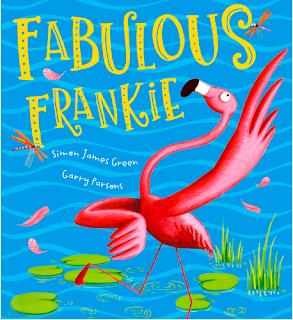 Fabulous Frankie by Simon James Green and Garry Parsons
Fabulous Frankie by Simon James Green and Garry Parsons
<font size="4"><font size="3">@font-face {font-family:"MS 明朝"; mso-font-charset:78; mso-generic-font-family:auto; mso-font-pitch:variable; mso-font-signature:-536870145 1791491579 18 0 131231 0;}@font-face {font-family:"Cambria Math"; panose-1:2 4 5 3 5 4 6 3 2 4; mso-font-charset:0; mso-generic-font-family:auto; mso-font-pitch:variable; mso-font-signature:-536870145 1107305727 0 0 415 0;}p.MsoNormal, li.MsoNormal, div.MsoNormal {mso-style-unhide:no; mso-style-qformat:yes; mso-style-parent:""; margin:0cm; margin-bottom:.0001pt; mso-pagination:widow-orphan; font-size:12.0pt; font-family:"Times New Roman"; mso-fareast-font-family:"MS 明朝"; mso-fareast-theme-font:minor-fareast; mso-ansi-language:EN-US;}p {mso-style-noshow:yes; mso-style-priority:99; mso-margin-top-alt:auto; margin-right:0cm; mso-margin-bottom-alt:auto; margin-left:0cm; mso-pagination:widow-orphan; font-size:10.0pt; font-family:"Times New Roman"; mso-fareast-font-family:"MS 明朝"; mso-fareast-theme-font:minor-fareast;}span.a-text-bold {mso-style-name:a-text-bold; mso-style-unhide:no;}.MsoChpDefault {mso-style-type:export-only; mso-default-props:yes; font-size:10.0pt; mso-ansi-font-size:10.0pt; mso-bidi-font-size:10.0pt; mso-fareast-font-family:"MS 明朝"; mso-fareast-theme-font:minor-fareast; mso-fareast-language:JA;}div.WordSection1 {page:WordSection1;}</font></font>
The hero in Fabulous Frankie by Simon James Green and Garry Parsons is a flamingo who just wants to be fabulous. But how? He's literally surrounded by so many fabulous flamingos, how on earth can he stand out from the crowd? Frankie's friends help him to discover the most important thing of all: the best way to be fabulous is to be YOU!
Celebrate it on International Being You Day on 22 May.
And today?
Today 14 February, is International Book Giving Day!
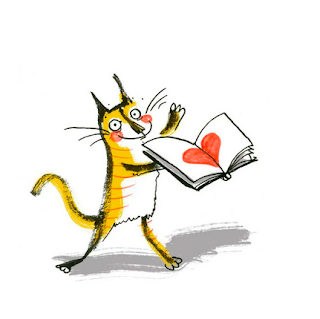 Artwork for International Book Giving Day by Viviane Schwarz
Artwork for International Book Giving Day by Viviane Schwarz
Will you be a book fairy or book ninja and leave a trail of enticing books around your neighbourhood for kids to pick up and discover? Along the school run, the dentist's waiting room, on the swings, on the walk to the library . . . You can tuck your bookmarks and bookplates inside. Join in the fun!
________________________________________________________
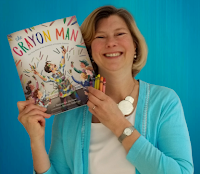 Natascha Biebow, MBE, Author, Editor and Mentor
Natascha Biebow, MBE, Author, Editor and Mentor Natascha is the author of the award-winning The Crayon Man: The True Story of the Invention of Crayola Crayons, illustrated by Steven Salerno, winner of the Irma Black Award for Excellence in Children's Books, and selected as a best STEM Book 2020. Editor of numerous prize-winning books, she runs Blue Elephant Storyshaping, an editing, coaching and mentoring service aimed at empowering writers and illustrators to fine-tune their work pre-submission, and is the Editorial Director for Five Quills. She is Co-Regional Advisor (Co-Chair) of SCBWI British Isles. Find her at www.nataschabiebow.com
<font size="4"><font size="3">@font-face {font-family:"MS 明朝"; mso-font-charset:78; mso-generic-font-family:auto; mso-font-pitch:variable; mso-font-signature:-536870145 1791491579 18 0 131231 0;}@font-face {font-family:"Cambria Math"; panose-1:2 4 5 3 5 4 6 3 2 4; mso-font-charset:0; mso-generic-font-family:auto; mso-font-pitch:variable; mso-font-signature:-536870145 1107305727 0 0 415 0;}p.MsoNormal, li.MsoNormal, div.MsoNormal {mso-style-unhide:no; mso-style-qformat:yes; mso-style-parent:""; margin:0cm; margin-bottom:.0001pt; mso-pagination:widow-orphan; font-size:12.0pt; font-family:"Times New Roman"; mso-fareast-font-family:"MS 明朝"; mso-fareast-theme-font:minor-fareast; mso-ansi-language:EN-US;}.MsoChpDefault {mso-style-type:export-only; mso-default-props:yes; font-size:10.0pt; mso-ansi-font-size:10.0pt; mso-bidi-font-size:10.0pt; mso-fareast-font-family:"MS 明朝"; mso-fareast-theme-font:minor-fareast; mso-fareast-language:JA;}div.WordSection1 {page:WordSection1;}</font></font>
<font size="4"><font size="3">@font-face {font-family:"MS 明朝"; mso-font-charset:78; mso-generic-font-family:auto; mso-font-pitch:variable; mso-font-signature:-536870145 1791491579 18 0 131231 0;}@font-face {font-family:"Cambria Math"; panose-1:2 4 5 3 5 4 6 3 2 4; mso-font-charset:0; mso-generic-font-family:auto; mso-font-pitch:variable; mso-font-signature:-536870145 1107305727 0 0 415 0;}p.MsoNormal, li.MsoNormal, div.MsoNormal {mso-style-unhide:no; mso-style-qformat:yes; mso-style-parent:""; margin:0cm; margin-bottom:.0001pt; mso-pagination:widow-orphan; font-size:12.0pt; font-family:"Times New Roman"; mso-fareast-font-family:"MS 明朝"; mso-fareast-theme-font:minor-fareast; mso-ansi-language:EN-US;}p {mso-style-noshow:yes; mso-style-priority:99; mso-margin-top-alt:auto; margin-right:0cm; mso-margin-bottom-alt:auto; margin-left:0cm; mso-pagination:widow-orphan; font-size:10.0pt; font-family:"Times New Roman"; mso-fareast-font-family:"MS 明朝"; mso-fareast-theme-font:minor-fareast;}span.a-text-bold {mso-style-name:a-text-bold; mso-style-unhide:no;}.MsoChpDefault {mso-style-type:export-only; mso-default-props:yes; font-size:10.0pt; mso-ansi-font-size:10.0pt; mso-bidi-font-size:10.0pt; mso-fareast-font-family:"MS 明朝"; mso-fareast-theme-font:minor-fareast; mso-fareast-language:JA;}div.WordSection1 {page:WordSection1;}</font></font>
<font size="4"><font size="3">@font-face {font-family:"MS 明朝"; mso-font-charset:78; mso-generic-font-family:auto; mso-font-pitch:variable; mso-font-signature:-536870145 1791491579 18 0 131231 0;}@font-face {font-family:"MS 明朝"; mso-font-charset:78; mso-generic-font-family:auto; mso-font-pitch:variable; mso-font-signature:-536870145 1791491579 18 0 131231 0;}p.MsoNormal, li.MsoNormal, div.MsoNormal {mso-style-unhide:no; mso-style-qformat:yes; mso-style-parent:""; margin:0cm; margin-bottom:.0001pt; mso-pagination:widow-orphan; font-size:12.0pt; font-family:"Times New Roman"; mso-fareast-font-family:"MS 明朝"; mso-fareast-theme-font:minor-fareast; mso-ansi-language:EN-US;}.MsoChpDefault {mso-style-type:export-only; mso-default-props:yes; font-size:10.0pt; mso-ansi-font-size:10.0pt; mso-bidi-font-size:10.0pt; mso-fareast-font-family:"MS 明朝"; mso-fareast-theme-font:minor-fareast; mso-fareast-language:JA;}div.WordSection1 {page:WordSection1;}</font></font>
February 6, 2022
Follow the pun! by Jane Clarke
I’ve never been able to resist a groan-making pun, and generally manage to insert a few in each picture book manuscript I write. They are almost invariably removed by editors because puns don’t work when translated into another language. For that reason, you can’t really build a picture book around a pun, but they might lead you to the story.
For example, when the publishers requested a frog as the character in the third book in a recent picture book series gloriously illustrated by Britta Teckentrup, the idea for the story (about a nervous frog leaping away from strange noises) came from a pun: What is a frog’s favourite game? - Leap Frog.
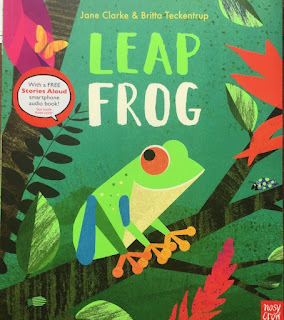
The title was used for the English language editions, but it was no surprise that it didn’t survive translation.
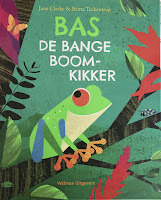
If you’re stuck for something to write, or bogged down in something you are writing, try pun-surfing. It will at least elicit a groan - and maybe even put a silly smile on your face and make a picture or an idea pop into your mind.
Take toads for example:
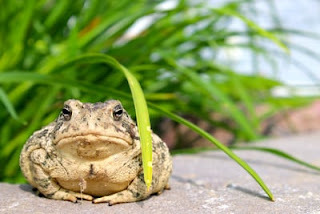
Puns might lead you to a Highway Toad who is toadally awesome. Or to cute toadlers who go to play school, leave their coats in the croakroom, have to learn the highway toad for road safety, dance to hip-hop, have a hopperation if poorly…
Yep, too many puns together are indigestible, but have a go. Take a topic you’re interested in and follow the puns. They might just be the spark you need to ignite your new picture book story.
The best times to look out for a pun? 5.30 and 6.30, hands down
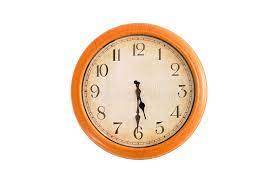
preferably accompanied by your watch dog, Rolex :-)
Jane was especially delighted by the number of puns that made it into the Gilbert books, where they were brilliantly illustrated by Charles Fuge.
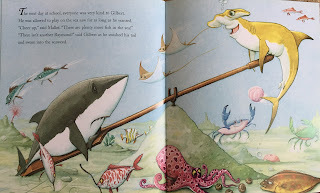 From Gilbert the Great
From Gilbert the GreatJanuary 23, 2022
Ask yourself a question: Why would I buy this book? By Moira Butterfield
It’s daunting, isn’t it, looking at all the picture books out there. How is it possible to get any success in such a crowded market? Well, it’s true that it IS very crowded. There’s no getting away from it. So how are you going to catch the attention of publishers and the public, assuming that you aren’t already a celebrity?
I think the best way is to plough your own furrow with a really strong idea that you feel passionate about. Only then will you create something that people will want to buy and use with their children. It’s a good exercise to rigorously examine your concept from the point of view of an agent, editor and buyer.
Ask yourself – How does your idea stand out from everything else already on the shelves? Why would a member of the public want to buy it, out of all the others on sale?
Will it stand out as a strong concept? Take a look at Amazon and have a stroll around the bookshops to spot your type of book. Is your concept already out there big-time? Now it’s true you might do quite a generic concept really well – say a sentimental ‘I love you to the Moon and back’ type of book - but the chances are it could end up looking like a lot of other books in the same vein and it might sink into the bookshop background unless you’re a big name.
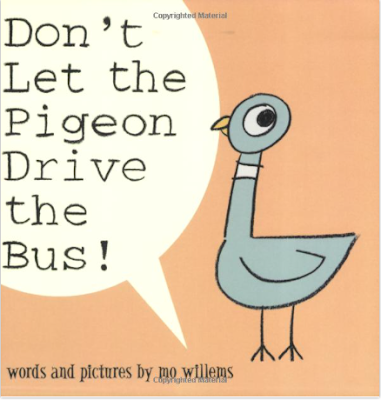 This book really stands out as unusual and looks a lot of fun. It was super-successful.
This book really stands out as unusual and looks a lot of fun. It was super-successful. 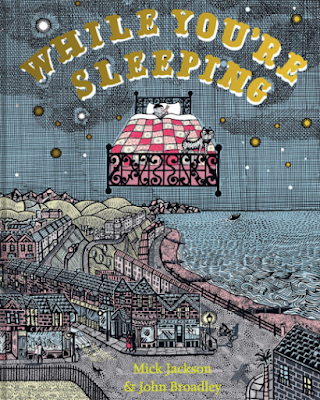 This concept is clear at first glance. It's great for bedtime.
This concept is clear at first glance. It's great for bedtime.
Is it going to appeal to enough people? Say you want to write a book that has a strong didactic message. I’d be very careful how you did that because most parents want a safe ride and a fun read when they pick up a book, which is why they would buy trustworthy Julia Donaldson over something that looks as if it might be browbeating. You’re going to need to think about how to make your message appeal to your audience, not put them off.
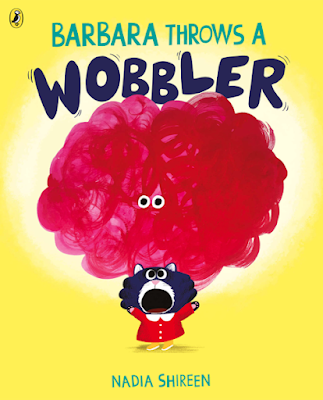 This is a great example of a 'message' topic done well. It's about telling a child to control their bad behaviour but it's handled in a really fun way that stands out. It definitely doesn't look preachy.
This is a great example of a 'message' topic done well. It's about telling a child to control their bad behaviour but it's handled in a really fun way that stands out. It definitely doesn't look preachy.
Will people think: “This book is going to be usable by me and my kids over and over again so I’ll buy it!” BLOG KLAXON: At this point I’m going to use one of my upcoming books as an example, I hope, of a thought-through concept. It’s Grandma’s Story – illustrated by Salvatore Rubbino and published by Walker on May 5th.
 The cover
The cover  The first spread
The first spread
This idea came from hanging out with my great-niece alongside my elderly parents. What unbelievably different childhoods they all had! Yet by the time my great-niece would be old enough to think about asking them questions would they still be around? I’d never asked my own grandparents anything about their early lives and regretted it. Added to that my great-niece would soon go to school, where she would immediately do ‘history’. How would she even know what that was? I set about creating a picture book that would connect kids to the grown-ups around them in a practical way that would really work. The artist and I have both put some of our own family history backgrounds into the book, which I hope gives it integrity.
So I knew this was a concept that people would really be able to benefit from. It thought it would appeal to a lot of people and I could see there wasn't another book like it. My agent and publisher agreed and so it is about to make it onto the shelves, where I hope the public will also notice it and agree.
Is your concept strong enough to persuade an agent/editor to sign up your book? You should resolve that before you approach them – marshalling your reasons so you can be as confident as you can be.
Oh, and you’ll need to write it, obviously... Good luck!
Moira Butterfield
moira@moiraworld.co.uk
www.moirabutterfield.co.uk
twitter @moiraworld
instagram @moirabutterfieldauthor
January 16, 2022
22 Picture Books to Look Forward to in 2022! by Clare Helen Welsh
2021 was a fantastic year for picture books, but will 2022 be able to top it?!
By the looks of the titles publishing this year, that seems highly likely!
Here are 22 of the picture books that caught my eye.
1. I AM NOT A PRINCE, by Rachael Davis and Beatrix Hatcher
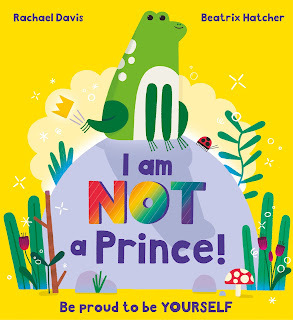
A heart-warming fairy tale for the 21st century that challenges gender stereotypes and encourages children to be proud to be themselves.
On a misty lagoon in a fairy tale land, young frogs wait patiently to be turned into magical princes. But one little frog is different . . .
Hopp definitely does NOT want to be a prince! When Hopp sets out on a journey to find their true self, everyone assumes the little frog is destined to be a prince . . . how could such a strong, brave, and kind frog be anything else? But all it takes is one understanding new friend to help Hopp undergo a magical transformation that causes a positive change to ripple all across the lagoon!
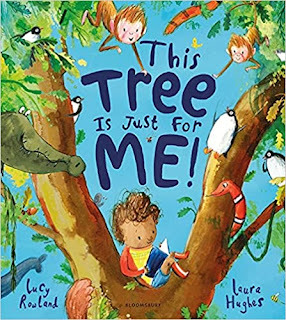
Jack has a new book, and he's found the perfect place to read in peace - a big, beautiful tree.
So when a tiger, a bear, an alligator and a whole host of unusual animals ask if they can join him, Jack says, 'NO! This tree is just for me!"
But you've got to be careful what you wish for. When the animals go away, Jack begins to wonder whether keeping something to yourself is so much fun after all. Sometimes, a tree is EVEN better with friends in it too!
This Tree is Just for Me is a charming and uplifting tale of friendship and sharing that will delight children and parents alike.
3. DADDY'S RAINBOW, by Lucy Rowland and Becky Cameron
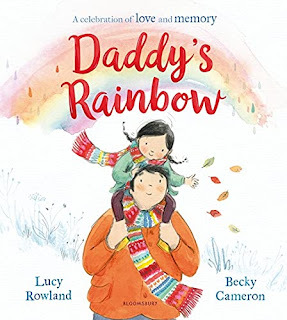
Erin's daddy sees the colour in everything. Even on the greyest days, they put on their wellies and go splashing in puddles because, Daddy says, 'We can't see rainbows without rain!'
But what happens when the greyest day of all comes, and Daddy isn't there any more? Can Erin learn to find colour in the world again?
This deeply sensitive picture book about the loss of a parent is the ideal starting point for conversations about love, loss and learning to live again.
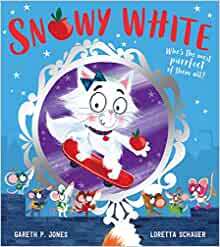
Kingsley is the finest cat in the kingdom. How does he know? His crystal ball tells him so!
But one day, the crystal ball has a different story to tell. A new cat by the name of Snowy White has arrived in the kingdom. She’s beautiful . . . she’s kind . . . and Kingsley is determined to get rid of her.
Luckily, though, Snowy gets a helping hand – or seven – from some very special new friends!
The third hilarious title in a fun-filled fairytale series with empowering messages for young readers! Look out for Rabunzel and Cindergorilla
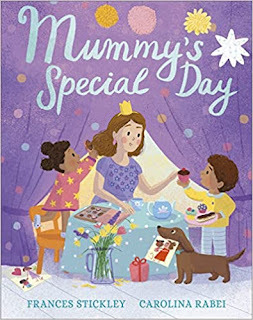
Mummy makes every day special, so it's about time she had her own perfect day full of all her favourite things.
Mummy makes us happy even when it's hard to do, wouldn't it be wonderful to make her happy too?
This brother and sister know exactly what Mum loves: her favourite foods, flowers, and pictures painted by them. They arrange it all for Mummy's special day, but nothing seems to go to plan. Luckily, the thing Mummy enjoys best is spending time with her little ones.
A heartwarming story, perfect to snuggle up with on Mothers Day, a birthday, or any special day at all!
6. DODOS ARE NOT EXTINCT by Paddy Donnelly
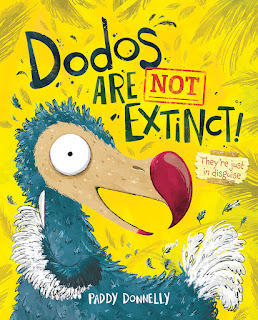
Psst! Hey you! Can you keep a secret? Dodos are NOT extinct!
In fact, if you look extra closely, you might be able to spot other extinct animals . . . like woolly mammoths, saber-toothed tigers, and even dinosaurs in this book! These famous creatures are in disguise everywhere, so keep your eyes peeled! You never know who might be right under your nose...
A hilarious, engaging primer on famous extinct—but never forgotten— animals that will keep kids giggling and guessing on every page.
7. ONE CAMEL CALLED DOUGH by Lu Fraser and Sarah Warburton

A warmly reassuring rhyming story (with a fun counting element!) about how it’s ok to need a little alone time, from the author of the award-winning The Littlest Yak.
Doug the camel is all alone and sometimes he wonders whether one is enough (it makes playing hide and seek terribly tough…). So when at first one, then two, then three, then four more camels turn up (followed by a whole camel herd), Doug delights in the possibilities all these new friends bring. But when Doug is ‘all camelled out’ from all the excitement and it's time to count down to bedtime, he takes just as much pleasure from the peace of being alone once again.
Lu Fraser’s warm, funny text is a delight to read out loud and is brilliantly illustrated by Sarah Warburton in the first book from this exciting new picture book partnership.
8. MY MUM IS A LIONESS by Swapna Haddow and Dapo Adeola
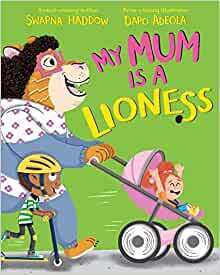
Run! Hide! My mum's a lioness and she's on the prowl.
Is Mum a lioness? She loves her 'cubs', she can run faster than anything, and she can catch you in a single pounce for cuddles and kisses. She always makes sure you can hear her incredibly loud, proud roar. What else could Mum be but a lioness?
But sometimes, especially when her young ones are upset or scared, a lovely, warm, protective lioness embrace is just what is needed.
9. YES YOU CAN, COW! by Rashmi Sirdeshpande and Rikin Parekh
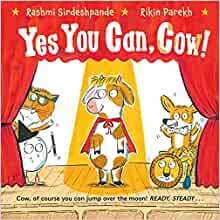
Yes, you can, Cow! We believe in you!
READY . . . STEADY . . . GO . . .
It's the Nursery Rhyme's big performance, but Cow is having second thoughts. She's too scared to jump! What if she crashes? Will everyone laugh?
The curtain's almost up and the audience are waiting. Can Cow overcome her fear of failure and become the star of the show?
A gorgeous, heartwarming story about believing in yourself and doing your best based on the ever-popular nursery rhyme 'Hey Diddle Diddle'.
10. EVERY BUNNY IS A YOGA BUNNY by Emily Ann Davison and Deborah Allwright
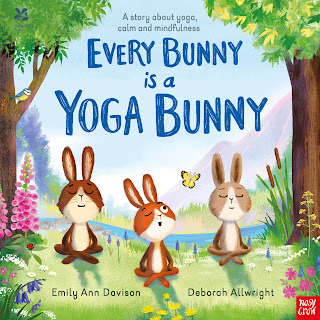 Yo-Yo is a fidgety, bouncy, can't-sit-still-EVER type of bunny. Even Grandpa's yoga class won't stop her wiggling and giggling. But what will Yo-Yo do when she finds herself lost and all alone in a shadowy forest? Maybe Grandpa's yoga will help...
Yo-Yo is a fidgety, bouncy, can't-sit-still-EVER type of bunny. Even Grandpa's yoga class won't stop her wiggling and giggling. But what will Yo-Yo do when she finds herself lost and all alone in a shadowy forest? Maybe Grandpa's yoga will help...With simple step-by-step instructions at the end, children can stretch, feel calm and be a yoga bunny too.
11. TRAINS, TRAINS, TRAINS by Donna David and Nina Pirhonen
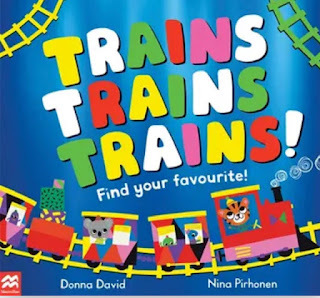
Big trains, small trains, short trains, long trains . . . which do you like best? Follow fifty colourful trains as they whizz along tracks and through tunnels – up, down, around and back again! Can you find your favourite?
Full of spotting and counting fun, with five trains to find on each page and an exciting fold-out race at the end, this rhyming preschool picture book from Donna David and Nina Pirhonen has been specially developed to encourage pre-reading skills and expand language and vocabulary. With a super-shiny foil cover and fun read-aloud text, Trains Trains Trains! is just the ticket for any transport-obsessed toddler!
12. WHO WILL YOU MEET ON DINOSAUR STREET by Gareth Peter and Tim Budgen
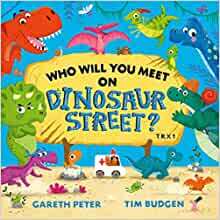
What is that stomping and stamping of feet?
It looks like a party on Dinosaur Street!
They’re all in a frenzy and eager to go
To the Fizz-whizzing Flash-tastic Fireworks Show!
Welcome to Dinosaur Street! Home to Flashysaurus, Splashysaurus, Whoops-there’s-been-a Crashysaurus, and a whole host of other loveable characters. With the most energetic rhythm and rhyme this is huge fun to read aloud and will encourage lots of reader engagement. The hilarious Who Will You Meet series is sure to become a repeat-read family favourite.
13. MY MUST-HAVE MUM by Maudie Smith and Jen Khatun
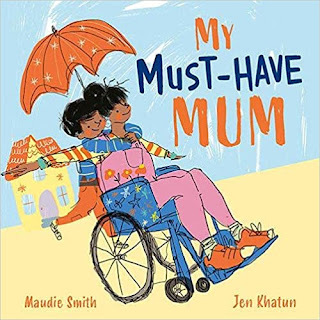
When Jake’s mum upcycles every last thing in the apartment, Jake begins to worry that the only thing left to change is . . . him!
Jake’s mum is not like most mums. Say there's a skip in the street, most mums will pass right by without a second glance. Not Jake’s mum. “Look at this, Jake!” she'll shout. “We must have this! We must have this, too! And we simply must have this!” That’s Jake’s mum for you. She’s a must-have mum.
Soon Jake begins to worry that his mum will want to change him too. Should he be this way? Or that way? Or another way altogether? A heartwarming story about the unbreakable bond between a mother and her son, and a little boy who learns that he is perfect just the way he is.
14. THE RIVER by Tom Percival
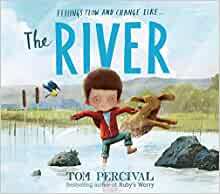
Rowan loves the river; it’s just like he is. On some days, it’s quiet and calm, on others it’s light and playful, and then there are the days when it roars along, wild and angry. But when Rowan goes through a particularly difficult winter, the river freezes – just like Rowan. Can Rowan find a way to release his frozen feelings, and allow the river to flow freely once more?
15. AN ARTIST’S EYES, by Frances Tosdevin and Clémence Monnet
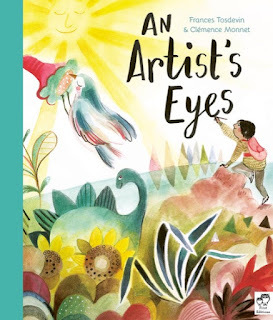
In An Artist's Eyes, follow Jo as he journeys through the world of colour and creativity in an empowering story of confidence and imagination.
Jo is a little boy who desperately wants to 'see like an artist'.
He tries as hard as he can to see things the way Mo the artist does, and when he starts to use his imagination, he realises that the things he can dream up are completely unique.
From the autumn oranges of the forest floor to pink and lilac pigeons in flight, Mo teaches Jo to trust his own eyes, and to see like an artist.
This is a magical story about the power of imagination and discovering that our individual perspectives make us all artists, and no two artist's eyes are the same.
16. BE BRAVE, LITTLE ONE by Olivia Hope and Daniel Egnéus
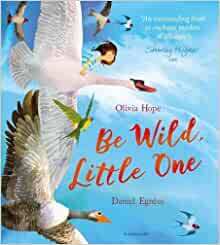
Wake up early, don't be shy.
This bright world can make you FLY . . .
This gorgeous, uplifting picture book celebrates the wildness in all of us, and the beauty of the world all around us. Prepare for a heart-lifting journey through the beauties of nature: from pine forests to awe-inspiring mountains, and from sparkling seas to starry skies, each page is full of wonders. Fly across oceans, run with wolves through the mountain snow, dance with fireflies, and prepare to BE WILD!
With a lyrical text from talented debut author Olivia Hope, and stunning, immersive illustrations by Daniel Egnéus, this stand-out book brims with joy and possibility and makes the perfect gift for any little one.
17. SUNSHINE AT BEDTIME! by Clare Helen Welsh and Sally Soweol Han
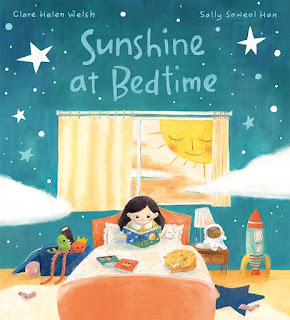
Curious Macie notices that the evenings are brighter in summer and wants to know why. Together Mummy and Macie discover the wonder of the Sun, just in time for bed. A beautiful, lyrical and reassuring bedtime story with a double-page spread of non-fiction facts at the end.
18. OLD FRIENDS by Margaret Aitken and Lenny Wen
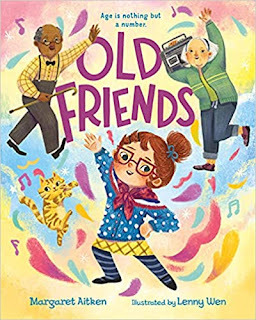
Paired with colorful and vibrant art by Lenny Wen, Old Friends is an inventive and heartfelt debut picture book that celebrates found family, caregiving, and the value of intergenerational friendships.
Marjorie wants a friend who loves the same things she does: baking shows, knitting, and gardening. Someone like Granny. So with a sprinkle of flour in her hair and a spritz of lavender perfume, Marjorie goes undercover to the local Senior Citizens Group. It all goes well until the Cha-Cha-Cha starts and her cardigan camouflage goes sideways. By being true to herself, Marjorie learns that friends can be of any age if you look in the right places.
19. THE BLUE BAGOO by Karl Newson and Andrea Stegmaier
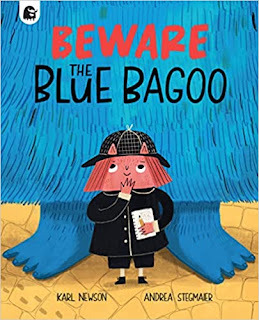
BEWARE the Blue Bagoo! Join in with the detective who is on the trail of this mysterious blue creature in this fun interactive adventure activity book!
A detective tries to uncover the truth about the infamous ‘Blue Bagoo’ – a creature so big and scary that it can’t possibly be made up, can it?
Our detective addresses us – the reader – on the very first page, and then walks the winding cobbled streets of a Dr Suess-esque seaside town, taking statements from the residents.
The Blue Bagoo proves elusive, but there are traces of its ‘supposed’ image scattered throughout the town. However, as the investigation procedes, there is a critical twist....
This is a tale of rumours and fears, that also teaches us a gentle lesson about jumping to conclusions and judging others!
20. BUT WOLVES IN HELICOPTERS by Sarah Tagholm and Paddy Donnelly
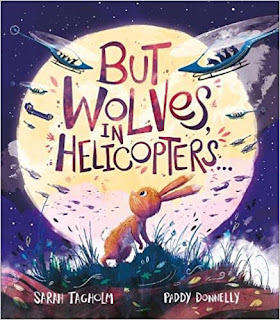
Can Hop find a way to escape the wolves in her nightmares, even if they chase her in helicopters? Mummy thinks so...
Every night, Hop has nightmares filled with, scary, hungry-eyed wolves. She knows they only exist in her dreams but they still seem very real. Her mummy comforts her and has some good advice, but will Hop must find her own strength to act it out.
21. STOMPYSAURUS by Rachel Bright and Chris Chatterton
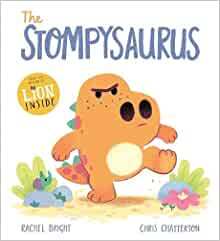
A reassuring tale about coping with overwhelming feelings and frustration, The Stompysaurus is the latest book in the DinoFeelings series by Rachel Bright and Chris Chatterton, creators of The Worrysaurus.
One morning, Stompysaurus wakes from a happy dream, feeling excited for the new day, until things start to go a bit wrong. His brother's being a tease, his breakfast isn't his usual favourite and NOTHING is going right. His STOMPS and ROARS start rising inside him, until they EXPLODE!
But a tricky start doesn't have to mean a stompy finish. Can Stompysurus find a new way of looking at things and turn his day around?
The perfect picture book to help children learn to overcome feelings of anger and annoyance when it seems like everything is going wrong.
22. I DEFINITELY DO NOT LIKE WINTER by Fiona Barker and Christine Pym
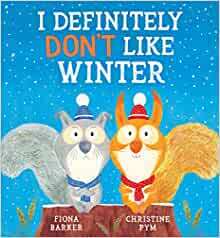
A brilliantly funny picture book about two best friends who just can't agree!
Hank and Hoog are best friends - they do EVERYTHING together.
Until one morning, when a single, crisp, brown leaf falls to the ground...
Hank is so annoyed! Falling leaves mean winter is coming, and Hank definitely does not like winter. BRRRRRRR!
But Hoog is overjoyed! Hoog loves winter - the snow, the snuggles, all of it! AHHHHHHH!
Will these two friends learn to put their differences aside? You bet they will! They may not agree on winter, but there's something they both definitely like: each other.
And there's nothing more important than being best friends.
January 10, 2022
Extra income stream -and so much more. The value of RLF Fellowships for picture book writers by Juliet Clare Bell
I don’t know about you but I feel really uncomfortable about the money side of writing, and writing-related events (author visits, etc.). I feel very lucky to have an agent who deals with contracts so I don’t have to do the excruciating discussions or negotiations with editors or publishers. Occasionally I do (when it’s a slightly different kind of writing project not covered by my agent) but the less I can have to do with the financial side of it the better. I struggle with the admin for anything but there’s something I find so uncomfortable about sending invoices that it’s enough to make me think twice about taking certain writing events on. And don’t remind me about January 31sttax deadline… (or you probably should, because I forget, many times every day and then have a jolt of remembering and write it down again)
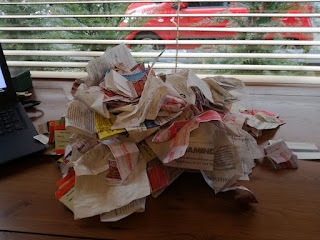
Eek. So talking about finances in a blogpost doesn’t come naturally to me at all, but it’s something we have to do if we’re going to write for our living.
The vast majority of published picture book authors (and other authors) don’t make a living from their books alone, and here is where the RLF (Royal Literary Fund) Fellowship comes into play. I’d heard about RLF Fellowships years ago from my brother-in-law who works in university libraries, and he’d suggested I apply for one. The Royal Literary Fund is a charity that supports authors, and RLF Fellows spend two days a week (during term time) at a university
 University of the West of England (UWE)'s Frenchay Campus where I'm one of the RLF Fellows
University of the West of England (UWE)'s Frenchay Campus where I'm one of the RLF Fellows
having one-to-one sessions with students about their writing, and a further half day doing the admin, arranging sessions, writing up reports etc. The RLF provides you with a grant given out at the beginning of each term, and it’s generous enough so you can afford to spend the rest of the week writing -and if you don’t earn anything from your books in that year, you’ll still earn more than the average annual earnings for a writer in the UK (I think that’s around £11000 per annum). So it protects writing time for you, and it’s amazing.
It took me over six years after my brother-in-law suggested it to me for me to pluck the courage to apply. You need to have published at least two or three traditionally-published books (I can’t remember exactly) if you’re an author (if you’re a journalist or playwright, it’s slightly different). I looked at some of the people who had Fellowships and I didn’t see any picture book authors, and many of the writers were well-known and had long lists of awards (in fact, my fellow Fellow at UWE last year had previously won the Costa Novel, Costa Book of the Year, James Tait Black Memorial Prize, and had been on loads of impressive shortlists). It didn’t feel like I was worthy of a Fellowship or that I would be successful if I tried. However, six year after forgetting about it, then remembering (and dismissing it as unrealistic) and forgetting, and remembering (and dismissing etc.), I decided to give it a go.
By the time I applied, I knew quite a few other children’s authors who were doing it, or were about to start (still, none of them picture book writers) and I started my application. Successful Fellows suggested that I be really honest in my application and talk not only about things that had gone well for me with my writing, but things that I’d struggled with (and what I’d learned from my own mistakes and struggles and how that could help students). RLF Writing Fellows work with university students to help them with all aspects of writing so I dug deep and thought about anything personal that I might bring to the sessions with students that related to picture books in particular and writing struggles in general. Preparing the application made me focus on how a really good understanding of picture book structure for me might help me help students with their own assignments (mostly essays) and which aspects of writing I feel I have good insight into and which I find really hard I also thought about what I struggled with in university myself. I actually used to work as an academic in university and the thing that I struggled with the most? Definitely the writing!
I was concerned that I’d been too honest in my application but I was over the moon when I was taken on! Even when I had doubts (over all those years) that I wouldn’t be successful in an application, I knew two things: one, that I would like it, and two (for the couple of years before I dared apply, at least) that I actually did believe I had something to offer to the students and that I could do a good job of it.
If you think that it sounds like something you’d be able to do well, and that you’d enjoy (the challenge of helping each student you see to improve on their own work/find better ways of studying, reading and writing) -and you’re eligible in terms of number of books traditionally published, then I’d highly recommend applying -even if you don’t think there’s a great chance of success. I know now at least two other picture book authors who are doing this and I suspect there are others. It’s got to be worth a try!
What I’ve gained from being an RLF Writing Fellow
There is, of course, the financial side to getting a Fellowship (and it was extremely helpful in lockdown where school visits are very few and far between). There is huge value in that relief of knowing there’s money coming in from your writing-related activities whether or not you sell any books. But there’s so much more to it than that.
Having an RLF Fellowship has allowed me, and continues to allow me, to explore. The RLF is there to support writers and so I am justified in researching things beyond what I might be writing right now and allow myself to play when thinking about what I write and what I want to write. I have read more in the last eight months or so than I have in the previous thirty (where I read very little). It’s given me the freedom to think about everything and how that can all fit into writing and any writing-related activities. The Fellowships are generally for two years (so more writers can benefit from them) and although it’s helped me during my Fellowship, it’s actually changed the way I think about lots of things in relation to what I’m really interested in writing, and how I’d like to write it. The benefits from the freedom to write and know you’re financially secure for those years, and the acknowledgement that this is actually you, a writer -and will continue to be you for the long term will continue for the rest of my life.
In terms of the actual sessions with the students, I love them! I enjoy it even more than I thought I would (and it’s especially good to do in-person sessions after a year of seeing students online from home). I enjoy the fact that I’m put on the spot (which I’ve often hated in the past) but because as a writer, I really do feel like I have something to offer them, it’s an exciting exchange where we explore problems and issues together. I think it has been part of the reason I realised I had ADHD because I had time to stop and examine myself a bit and that I was recognising myself in so many of the students who were struggling with procrastination and starting and finishing things, and easily going off-topic. In fact the things that have held me back for so many years and been really hard (which have turned out to be because of ADHD) are the some of the things that can really help you when working with some of the students. It’s a privilege to be able to work with students and be authentic so you can come up with strategies and suggestions that will help them move forward with their writing and studying. I feel very lucky, and I’ve learned loads from the students and from the sessions.
All my life I’ve struggled with admin and the RLF admin is much less onerous than many other things. Students come with a piece of work you’ve not seen before so you work on it there and then and the appointment system works really well and it sends things out for you without having to understand how it does it. And for the admin that needs to be done? I have my wonderful picture book accountability partner who stays on a skype call, silently, for an hour a week, her working on her stuff, and me on my admin, but I know she’s there so I have to get it done!
There are lots of different ways to earn extra writing-related income. If you genuinely think you’d like working individually with university students to help them improve their writing, and you can really think about how what you write and the way you write and organise your writing life could help them (and you’re in the UK), then do consider applying for an RLF Writing Fellowship -even if you think you might not stand much of a chance. I know the experience has changed me in a really positive way and that it’s affecting what I’m writing and how I’m thinking about writing.
Good luck!
Juliet Clare Bell (always called Clare) has written over thirty picture books and early readers and is working on a young adult novel. She feels very lucky to be working as an RLF Writing Fellow.
January 2, 2022
Welcome to 2022 by Chitra Soundar
Welcome to 2022. We here at Picture Book Den hope you all had a wonderful Christmas even if it wasn’t as fabulous as it should have been before the pandemic hit us.
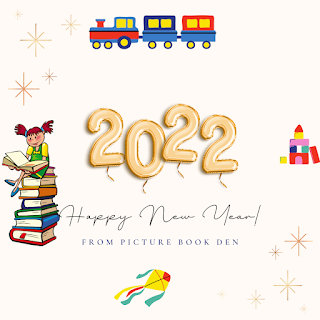
As autumn recedes and winter sets in, many communities and families in the world come together to celebrate. And most celebrations include visiting family, doing traditional rituals together and family meals.
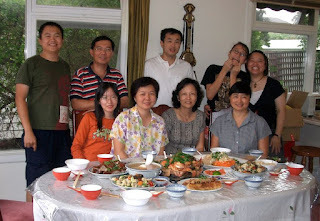 CC license
CC licenseWhile these celebrations are moments of joy, days filled with good food, old stories and making new traditions, often we also get upset or angry or hurt. Families know us well, they love us a lot and therefore can hurt us a lot too.
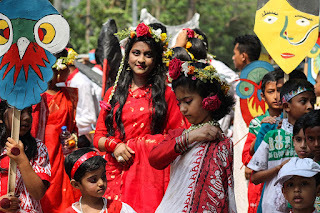 "Bangladeshi children wearing sari at Pohela Boishakh celebration (02)" / CC-BY-SA-4.0
"Bangladeshi children wearing sari at Pohela Boishakh celebration (02)" / CC-BY-SA-4.0Children experience heightened emotions during such gatherings. Lots of excitement with extended families, presents, more treats. But also such gatherings involve sharing their bedrooms or toys or doing things with others even if they don’t feel like it.
As a child, I’ve experienced both the highs of celebrations especially during Diwali – with fireworks and sweets and the lows of aunties telling me off or sharing my fireworks or following the lead of older cousins.
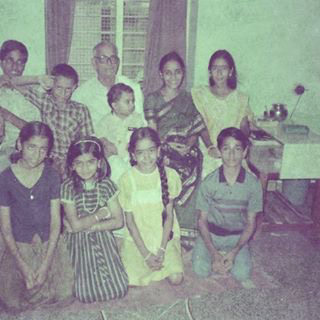 Can you spot me in the top right corner?
Can you spot me in the top right corner?Extending these experiences to being a picture book writer, I’ve written about both these situations. In my picture book Shubh Diwali!, illustrated by Charlene Chua, we feature a family who is having fun during the celebrations.
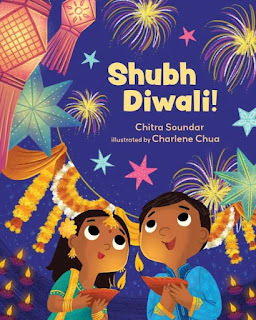
In my recent non-fiction picture book, We All Celebrate, illustrated by Jenny Bloomfield, I talk about amilies and loved ones across the world coming together to celebrate in many different ways.
But as I said there is another side to all family gatherings. Things that annoy us, make us sad or angry or disappointed.
In my new picture book Holi Hai!, illustrated by Darshika Varma, just released on 1st January 2022, I show the other side – what happens when emotions run over, tempers fly and nothing seems joyous.
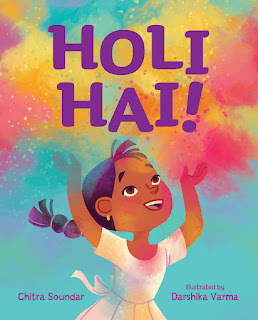
Young children, especially at the picture book age, don’t have a lot of history behind them. They are discovering their emotions and their own temperament. And so, celebrations offer the perfect storm for not just joy but also tantrums, stubbornness and frustration.
However, picture books not only offer a mirror of the behaviour – be it throwing a tantrum or being upset or even being hyper – they also offer a doorway into learning about how to deal with those emotions.
But such doorways must not be didactic or cautionary.
The picture books must acknowledge that such emotions are normal and then offer tools to harness the negative emotion and turn into a positive force.
So, to show and not just tell, I have included a few examples here. The stories below demonstrate how to integrate a celebration with an emotion and offer a positive outlook for the young reader.
To be honest, I struggled to find UK books for these – especially for a celebration that’s not Christmas. (That’s a hint for all writers from under-represented backgrounds, fill the gap!) So I’ve picked some from the US too.
In Fiesta Dress: A Quinceañera Tale By: Caren McNelly McCormack Illustrated by: Martha Aviles, a little girl feels left out in a big family celebration. No one is paying attention to her and yet finally even though she’s not the star of the occasion, she finds a way to save the day.
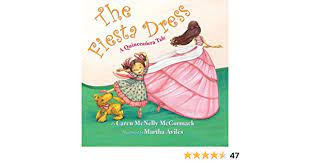
This story weaves through the rituals of the celebrations with the emotions of the young protagonist who’s feeling left out and of course she joins in by helping out. Where was this book when I attended a wedding where I was feeling so left out and it never occurred to me that all I had to do was join in.
In Nadia’s Hands, written by Karen English and illustrated by Jonathan Weiner, Nadia is worried about putting mehndi on her hands to be a flower girl at her aunt’s wedding, because that will NOT help her blend in at school.
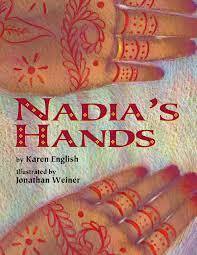
Again, this story juxtaposes the joy of the wedding with the reality of living in a western society for a child from a Pakistani background. It’s all ok to dress up and colour your hands with mehndi. But will my friends laugh at me?
This resonated with me so much as a South Asian living in the UK, I often try to tone down our traditions especially when our celebrations are not public holidays and I have to go into work.
In this picture book The Dreidel That Wouldn't Spin: A Toyshop Tale of Hanukkah by Martha Seif Simpson and Durga Yael Bernhard, it’s all about sharing and not being greedy. Haven’t we all been in a situation we get a present for Christmas or for birthday and are forced to share with our siblings or cousins or friends?
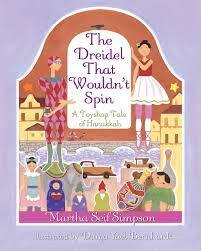
From Hanukkah to Christmas, Tom Fletcher’s The Christmasaurus and the Naughty List illustrated by Shane Devries, sends Christmasaurus on a mission to clear out the naughty list. It’s about remorse but also about understanding. Remember what I said showing how to deal with our negative emotions and also showing empathy when someone else is upset.
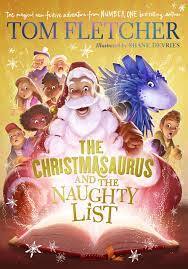
When it’s not about the internal emotions of children, your picture book can be about dangers that we all face during family celebrations. The big cousins that are rude or perhaps siblings who are behaving badly or a crazy aunty who pinches your cheeks. Perhaps that’s what inspired Nick Butterworth’s Jingle Bells in which two mice want to celebrate a lovely Christmas but they have a problem – the cat.
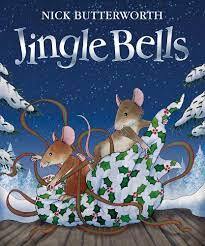
And finally, I thought it will be apt to end with a New Year story. Although my example is about the Chinese New Year.
As a writer and as a child, some of us have regrets about the past year. Not the ones you couldn’t control – but the ones you were able to. Say for example, you had made new year resolutions last year but failed to keep any of them. Or a child promised to tidy their room every week but failed often.
A brand-new year is here and therefore we must find a way to leave those regrets behind and form new habits, do new things, aim for things we can achieve. And that’s what this picture book This Next New Year by: Janet Wong Illustrated by: Yangsook Choi talks about. In this story, a boy must come to terms with things that didn’t happen in the current year and must look forward with hope for the upcoming new year.
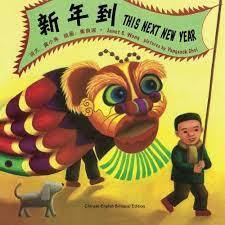
The books I've included in the list below have a range of ways to introduce the festivities alongside the emotion. From magical characters to mice, or real-life children in contemporary settings, stories can be told differently.
The job as a picture book writer is to find that unique twist, inside the traditional and familiar setting of the celebration and find a character that we can all root for, even if they are behaving badly. Easy? No! Fun and challenging, oh yeah!
So as the first post of the new year, 2022, I offer all picture book writers a challenge!
Step 1: Identify 6 joys that children experience.
Step 2: List each and mind-map each.
Step 3: Identify 6 negative emotions children experience.
Step 4: List each and mind-map each.
Step 5: Allocate one alternating emotion for each month. So, if January is about being curious, February could be jealousy, March is then pride and so on…
Step 6: Write one picture book per month based on that emotion set inside a celebration - November can be a story about Diwali and anger, December can be Christmas and sharing, April can be Easter and jealousy.
No other rules. Read widely, mind-map crazy and fill that notebook!
Tip: Why don’t you find some new and interesting festivals and celebrations from my book – We All Celebrate?
Happy New Year to you all! Have a productive and fun-filled 2022.
Chitra Soundar is an internationally published, award-winning author and storyteller, who is inspired by mythology, culture and folktales from across the world. She believes every story needs to be celebrated and there is a story behind every celebration.
Her latest picture books are Holi Hai! And We All Celebrate. Find out more at http://www.chitrasoundar.com/ and follow her on twitter here and Instagram here.
December 20, 2021
Family Time! by the Denners
This time of year, everyone is thinking of family. With this in mind, the Picture Book Denners have each chosen a favourite picture book featuring a family - and we all send our warmest wishes to you and yours. Please feel free to add you favourites in the comments.
Five Minutes' Peace by Jill Murphy (chosen by Jane Clarke)
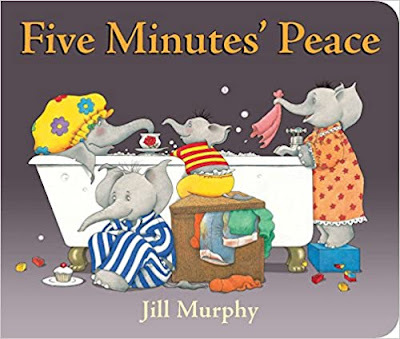 When my sons were small, I often read them Jill Murphy's picture books about the Large family. This one is my own personal favourite. At that time, I strongly identified with Mrs Large's attempts to find five minutes peace - ending in hilarity as her youngsters gate-crash her attempt to have a peaceful soak in the bath. My sons didn't understand it at all - why should Mum need five minutes on her own? Now they have young children of their own, they finally get it!
When my sons were small, I often read them Jill Murphy's picture books about the Large family. This one is my own personal favourite. At that time, I strongly identified with Mrs Large's attempts to find five minutes peace - ending in hilarity as her youngsters gate-crash her attempt to have a peaceful soak in the bath. My sons didn't understand it at all - why should Mum need five minutes on her own? Now they have young children of their own, they finally get it!
After 2 years apart and far too much peaceful time on her own, Jane finally made it to the USA, and is very grateful to be able to spend time with her youngest son and his family there - but even a grandma still needs the occasional 5 minutes' peace.
Welcome To Our World, written by Moira Butterfield, illustrated by Harriet Lynas, chosen by Pippa Goodhart
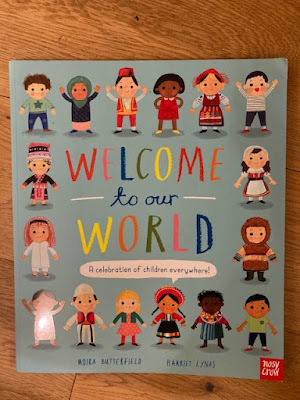
This is a glorious celebration of everyone in the world being part of the great world family of 7 billion people. With 64 pages of fun, looking at different manners and languages, food, schools, birthday traditions, games, toys, music, presents and more, we see quite how much variety there is amongst us, and yet what a lot we have in common. What happens in other countries when children lose a tooth? In Sri Lanka you throw your tooth onto the roof and ask a squirrel to bring you a new one. How can you be polite in different cultures? In Japan you slurp your noodles to show appreciation of the food! Maps to study, games to try, words to master, this book gives a taste of quite how interesting our big world family is. This is a family that we're all part of.
Wishing my family (that's you all!) a very happy Christmas indeed.
Mr Bear Babysits by Debi Gliori (chosen by Natascha Biebow)
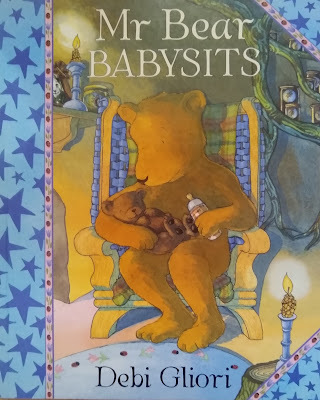
Debi Gliori is a master at capturing in words and pictures the nuances of family dynamics, especially in her Mr Bear series, now sadly out of print. I so admire how she manages to imbue her characters with a warmth and depth that is true to human nature – every one of us trying our best, but fallible at the same time. I chose Mr Bear Babysits because I love the children’s humorous antics as they try it on with poor inexperienced Mr Bear when he steps in last-minute to babysit for the Grizzle Bears while Mrs Bear stays home to try to settle their own grizzly baby. I can just imagine what this family would be like at Christmas time! I especially love the ending where Mr Bear offers Mrs Bear a cup of blueberry tea and a break from the crying baby with such love and kindness. And the final image of both Mr Bear and tiny baby tired out, asleep, is so heartwarming.
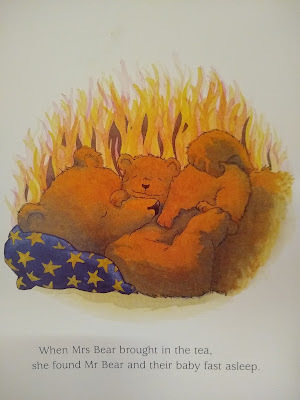 From Mr Bear Babysits by Debi Gliori
From Mr Bear Babysits by Debi GlioriThis is what family is to me – being there for each other through the ups and downs, and loving each other warts and all. Being far from family more often that not is a tough gig, especially during the holidays. Wishing you all a joyous season and thank you for supporting our blog!
My Daddies by Gareth Peter and Garry Parsons (chosen by Clare Helen Welsh)
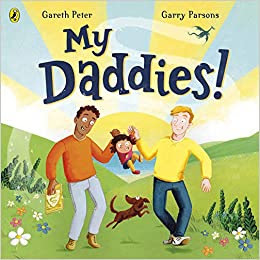
This bouncy, read aloud rhyming text encapsulates what family is to me. Adventure, creativity, imagination - including dragons, dinosaurs, space - then settling at home at the end of a long day for a cosy bedtime.
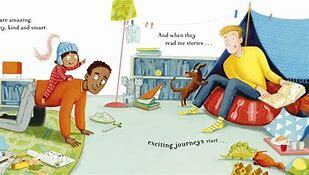
It's a heartwarming book inspired by Gareth's and Garry's experiences of both separately being in a same sex couple and adopted two young boys. In an effort to represent diverse families and their situation, they created this book and filled it with love for all children to enjoy. You can certainly tell that it comes from a personal and authentic place.
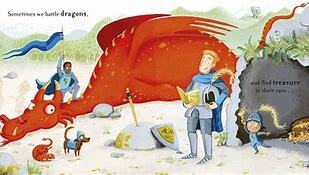
My Daddies, which has been illustrated by our very own picture book denner - Garry Parsons- is the first book published in the UK to be written and illustrated by same-sex couples. You can read more about their wonderful book and how it came to be, here. My Daddies! An interview with Gareth Peter and Garry Parsons | Young Writers
The Happy Hocky Family and The Happy Hocky Family moves to the Country! by Lane Smith (chosen by Garry Parsons)
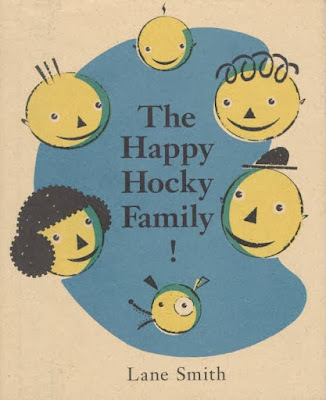
Meet the six members of the Hockey family - Mr, Hocky, Mrs Hocky, Henry, Holly and Baby Hocky, Newton the dog and occasionally Cousin Stinky.
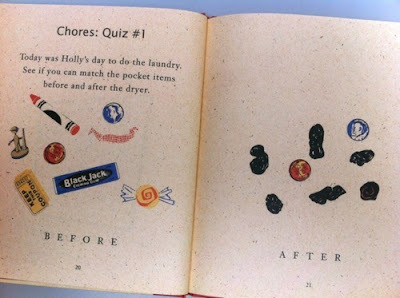
Follow the haphazard Hocky household as they stumble through the chores of daily life. Written in a dead-pan fashion similar to the Dick and Jane books and illustrated in a paired back graphic style, this is a funny, silly picture book with short sharp jokes on each page and lots of laughs. You both love and pity the family at the same time as they make a mess of the laundry and lose their teeth on toffee apples.
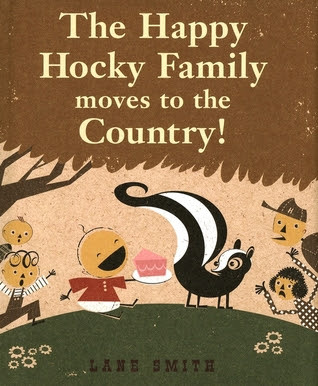
The Happy Hocky Family was first published in 1993 and its sequel, The Happy Hocky Family moves to the Country! came 10 years later in 2003, but was well worth the wait as it is equally as funny, if not funnier. Fed up with the city, the family move to the country for a more peaceful existence but have to learn the hard way that the countryside is very different form the city.
Read these books aloud with all the family!
Croc and Bird by Alexis Deacon (chosen by Mini Grey)
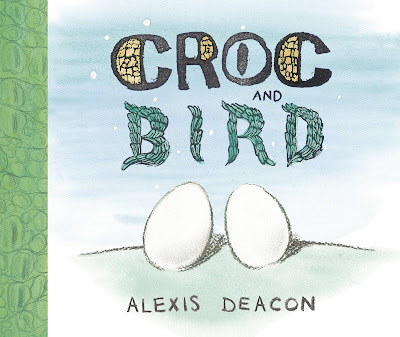
Croc and bird hatch side by side, and, without parents and not knowing any better, they bring each other up and discover how to be in the world together and grow big together.
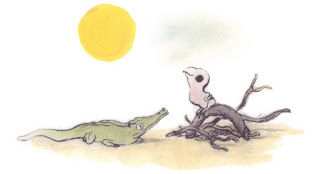

Here they are practising flying and lying like logs, basking on warm rocks, and fluffing up to keep warm.
But when they encounter a lake full of crocodiles and a forest full of birds, they realise they are not related after all.

Crocodile swims off to be with the crocodiles, and Bird flies off to be with the birds,
But their Croc & Bird ways of being don't fit with their new families. Crocodiles aren't supposed to sing or build nests, and birds aren't supposed to hunt buffalos or fly at night.
When neither of them can sleep, Bird finds Crocodile perched in a tree, and they realise they are each other's family, even if they happen to be different species.
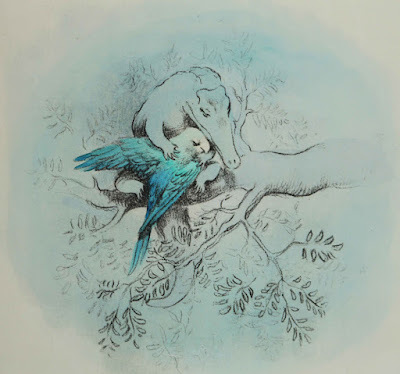
I think this book is about how sometimes you can forge your own unconventional family, that family can be a feeling of belonging together.
No Matter What by Debi Gliori (chosen by Juliet Clare Bell)
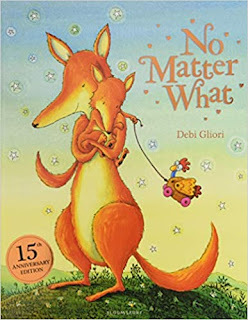
(c) Debi Gliori
I've chosen Debi Gliori's beautiful No Matter What, which encapsulates parental unconditional love.
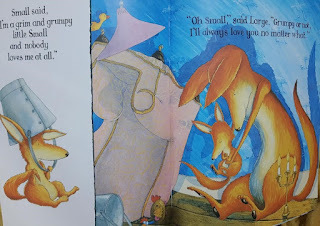
(c) Debi Gliori
Love bursts out of every page where Small is in a bad mood and thinks that no one loves him. Large reassures Small throughout -however outrageous a 'what if...?' suggestion Small makes (what if he turned into a bug, or a crocodile, for example?
This book was a favourite with my children and lots of their cousins when they were little. In fact, when my mum died, we put the book in the grave with her (and bought more copies) as she'd loved reading it with so many of her fifteen grandchildren. And Debi actually wrote me something utterly beautiful about unconditional love between mothers and children that we nearly, but couldn't quite, read out at the funeral as it was so poignant. You can tell that this book has been written and illustrated from the heart.
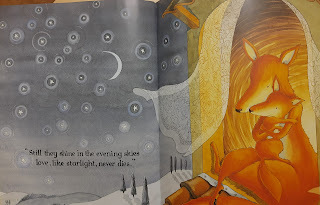
(c) Debi Gliori
It's such a beautiful book to read, and Large is a parent so could be a mother or a father. I know fathers who absolutely assume Large is a father, and I've always assumed Large is a mother. I think this makes it even more relatable to whoever is reading it (similarly with Small).
I'd recommend it for everyone, any time of year.
Have a wonderful, peaceful holiday x
PS You need to read the UK picture book edition (not the board book, and not the US edition -which removes all references to death although the fact that Large says that love, like starlight, never dies, is key to it all)
December 5, 2021
REJECTION! How to Find the Upside and Create Even Better Work by Natascha Biebow
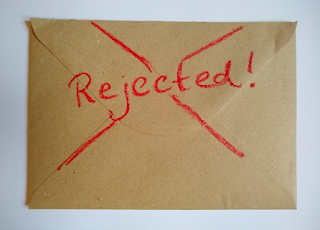
You’ve all heard them – the stories of how famous authors got hundreds of rejectionsbefore they got their book deal (and maybe even got rich).
And you’ve probably heard all the usual advice about how to deal with rejection:
- listen to feedback – join a critique group, cogitate those nuggets that a ‘nice’ rejection letter wings back to you and be prepared to revise.
- take a break and do something different; put your manuscript away for a while so that you can look at it again with fresh eyes.
- practise your craft – bum on seat, keep learning from other writers and take a course or do some mentoring if you can.
- listen to your gut – you know your story and sometimes you have to go right back to the beginning to find it.
- shelve your book; work on another project; always keep trying something new.
And . . . here’s the biggie:
Have courage and patience. Develop a thick skin!
Sounds easy on paper, right? But . . .
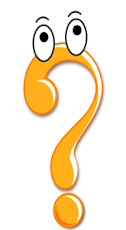
. . . rejections are hurtful. They sting. They seem like they are a failing on our part, as if they were a measure of our success and worth as authors. Rejections feel like something we should perhaps brush under the carpet. It’s much nicer to talk about good news . . . or the weather.
Even though they are so numerous and common – an everyday part of making it as a writer, really – we find it hard to TALK OPENLY about rejections.
But rejection is actually so commonplace that it should be a NORMAL part of being a writer, or indeed any creative. What if it were ‘normal’ to be rejected, something to be EXPECTED and that we shared more openly?
Rejection is, after all, really a bi-product of learning our craft – it means we’re taking risks and innovating!
If we never failed, we wouldn’t learn what we were good at. It would be difficult to keep improving and produce the best possible work. And, given that we’re creating for young readers, this is means we should be constantly stretching ourselves to make books that are worthy of our audience.
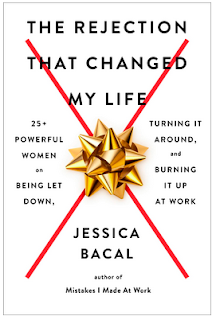
In her book THE REJECTION THAT CHANGED MY LIFE, Jessica Bacal shares some tips for reframing rejection that I’ve found helpful:
- Taking a leaf out of Professor Patricia Linville’s theory of ‘self-complexity’, which is the “phenomenon of having more than one ’self-aspect’, or definition of ourselves”, Bacal suggests considering rejection as just ONE part of your life, and instead focusing on other parts of your life about which you feel positive.
To do this, you can make a list of the things that you CAN do well. For fun, I had a go making a list of all the things I am good at that I wouldn’t put in my cover letter:
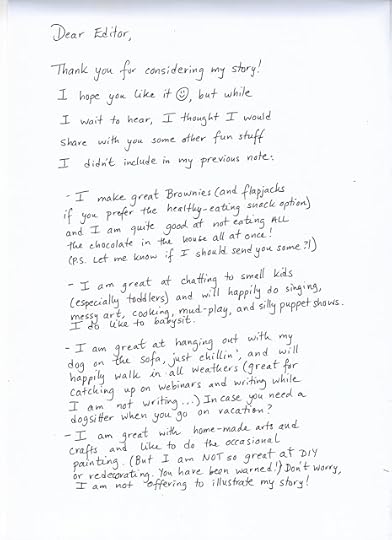

Bacal also suggests looking to psychologist Dr Kristin Neff’s theory of ‘self-compassion’ for inspiration. It has three parts:
1. First, acknowledge rejection – allow yourself to feel the pain of rejection and process all the emotions you need to feel.
2. Talk to yourself about the rejection as you would a friend and do something to make yourself feel better. Watch something funny, eat a cookie, binge watch your favourite TV show, share a laugh. Be compassionate towards yourself. Be KIND!
3. THEN normalize the rejection as part of a universal experience – we all experience rejections in life. Yes, make it normal. And, here’s the key:
If you can be part of a group connected in your suffering, this can really help! Having a writing community, such as SCBWI, can be key to helping you to deal with and move past rejection.
This rang true for me, certainly!
If rejection is the new normal for working writers, it will help us to build the emotional stamina to continue to create even better work. If we practise being rejected by failing often, it becomes easier to push ourselves to keep creating and becomes less crushing each time we get a ‘no’.
In the words of novelist Barabara Kingsolver:
“This manuscript of yours that has just come back from another editor is a precious package. Don’t consider it rejected. Consider that you’ve addressed it ‘to the editor who can appreciate my work’ and it has simply come back stamped ‘Not at this address’. Just keep looking for the right address.”
It’s important keep rejection in proportion.
Celebrating small wins and being kind is definitely helpful. But I’ve also begun to consider that maybe rejection can actually help me become morecreative, because it means I’m constantly having to pivot, re-consider my work, and think outside the box.
Rejection is not some scary THING out there. It’s just an ordinary, normal part of being a writer. It just means NO, not this and not yet.
YOU have the power to make it into a YES by being prepared to work at your craft. No one said being a writer was easy. Still, I am visualizing that YES!
________________________________________________________
 Natascha Biebow, MBE, Author, Editor and Mentor
Natascha Biebow, MBE, Author, Editor and Mentor Natascha is the author of the award-winning The Crayon Man: The True Story of the Invention of Crayola Crayons, illustrated by Steven Salerno, winner of the Irma Black Award for Excellence in Children's Books, and selected as a best STEM Book 2020. Editor of numerous prize-winning books, she runs Blue Elephant Storyshaping, an editing, coaching and mentoring service aimed at empowering writers and illustrators to fine-tune their work pre-submission, and is the Editorial Director for Five Quills. She is Co-Regional Advisor (Co-Chair) of SCBWI British Isles. Find her at www.nataschabiebow.com
@font-face {font-family:"MS 明朝"; mso-font-charset:78; mso-generic-font-family:auto; mso-font-pitch:variable; mso-font-signature:1 134676480 16 0 131072 0;}@font-face {font-family:"Cambria Math"; panose-1:2 4 5 3 5 4 6 3 2 4; mso-font-charset:0; mso-generic-font-family:auto; mso-font-pitch:variable; mso-font-signature:-536870145 1107305727 0 0 415 0;}@font-face {font-family:"Trebuchet MS"; panose-1:2 11 6 3 2 2 2 2 2 4; mso-font-charset:0; mso-generic-font-family:auto; mso-font-pitch:variable; mso-font-signature:647 0 0 0 159 0;}p.MsoNormal, li.MsoNormal, div.MsoNormal {mso-style-unhide:no; mso-style-qformat:yes; mso-style-parent:""; margin:0cm; margin-bottom:.0001pt; mso-pagination:widow-orphan; font-size:12.0pt; font-family:"Times New Roman"; mso-fareast-font-family:"MS 明朝"; mso-fareast-theme-font:minor-fareast; mso-ansi-language:EN-US;}.MsoChpDefault {mso-style-type:export-only; mso-default-props:yes; font-size:10.0pt; mso-ansi-font-size:10.0pt; mso-bidi-font-size:10.0pt; mso-fareast-font-family:"MS 明朝"; mso-fareast-theme-font:minor-fareast; mso-fareast-language:JA;}div.WordSection1 {page:WordSection1;}
November 28, 2021
Picture Book Horror! By Pippa Goodhart
I recently bought a very beautiful new picture book by Kate Read. It’s called One Fox, and it also has a strapline under that title; A Counting Book Thriller. That’s exactly what it is.
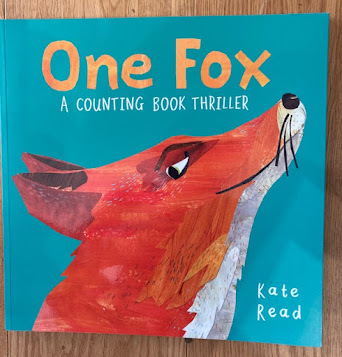
We count up from the ‘One famished fox’ to ‘Two sly eyes’, ‘Three plump hens’, ‘Four padding paws’, and on as the tension mounts between predator and prey; simple, exciting, and thrilling.
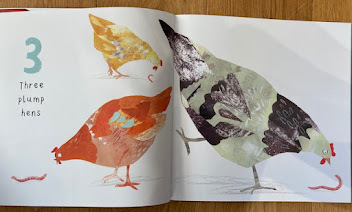
Then comes the moment of crisis. Really dark menace!

But of course all is not lost.
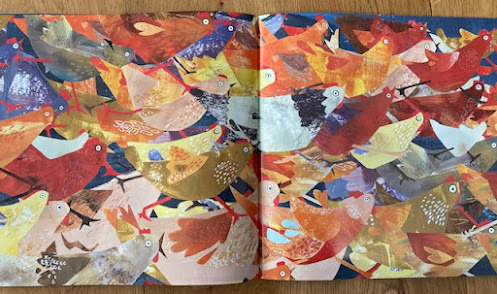
A great colourful rush of ‘one hundred angry hens’ turn the tables on the now ‘one frightened fox’ who is seen running away. A wonderful book!
Other picture books also deal with characters in mortal danger. There’s even a ‘best seller’ board book that does this for very young children.
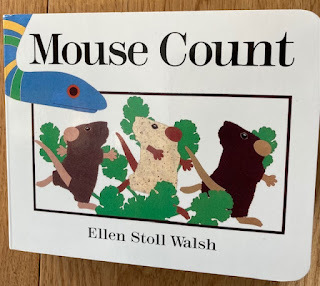
In Ellen Stoll Walsh’s Mouse Count a hungry snake goes looking for dinner, taking mouse after mouse, and popping them into a jar until, ‘Ten mice are enough. Now I am going to eat you up, little, warm, and tasty,’ said the snake. But of course the mice are clever, and trick their way to freedom. Phew!
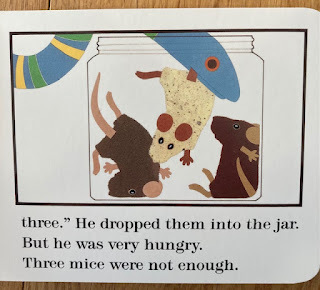
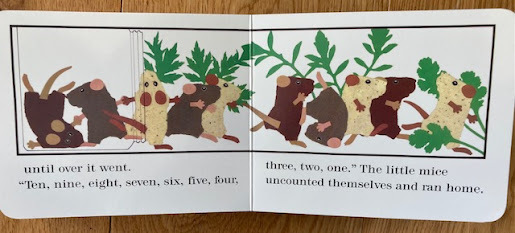
In both those stories, the intended victims get away, and the predator is left hungry.
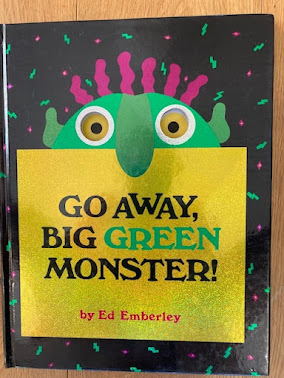
But another way to play horror to be fun rather than harrowing is to put the child reader in control. In Ed Emberley’s Go Away, Big Green Monster!, the text, and the child turning the pages, create a monster, brilliantly using layering of die-cut pages.


It builds and builds until we have the whole scary monster facing us. But the child who created the monster can then that process, telling the monster to ‘Go away’, and reducing its features one by one as we continue the page turning. By the end the monster is gone, and the text shouts, ‘GO AWAY, Big Green Monster!’ turn the page ‘and DON’T COME BACK! Until I say so.’ So it leaves with a new little thrill of possibility, but still under our command!
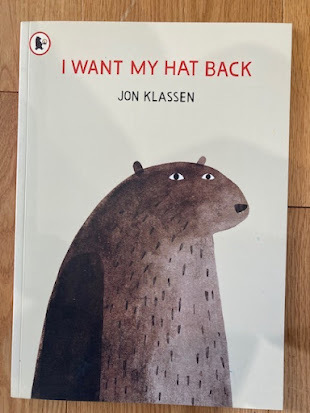
But what about Jon Klassen’s powerfully simple picture books, This Is Not My Hat and I Want My Hat Back, which give us the evidence and let us come to the conclusion that murder has actually been committed, albeit with strong reason? It is left to the child audience to join the dots and decide what has really happened, and then talk and think and talk some more about exactly what has occurred off-stage, and whether or not it was justified. When I first say I Want My Hat Back I thought it too worryingly scary to offer to a young child. But I was wrong. Most young children LOVE the thrill of it!
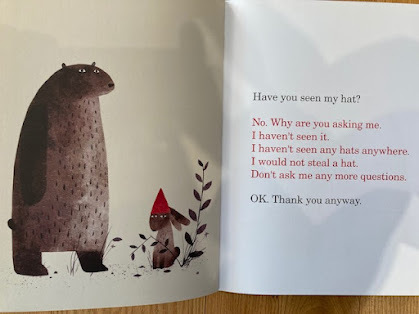
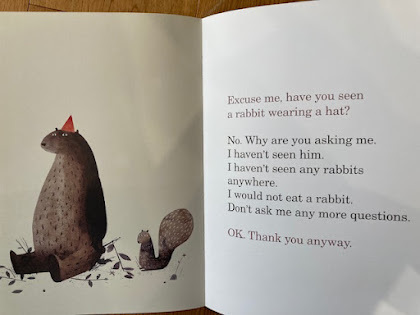
So, is there a line over which picture books should not step when serving up thriller stories? I think that all these examples show that the thrill is fun for children, just so long as we are in very clearly story territory, with characters who aren’t human. Such books are safe and fun places to play with the scary. Even for the very youngest children.
November 23, 2021
Down at the Picture Book Corner Shop with Mini Grey

I love all things shop: I’ve always wanted to have a dolls house shop. I also love all things packaging: packets, boxes, cans and paper bags. There’s joy in the selling of cakes and books (those are the only things I’ve ever sold). I love toy cash registers. And in your shop you can transform the value of a scrap of paper by it having a picture on it – that’s magic.
A shop window is like a theatre, lit up and glowing, beckoning on a dark winter afternoon. I remember as a child looking out for the magical lit up scenes of the Selfridges Christmas Windows, as we drove through London to my Grandparents in Kent.
Over October this year I thought I’d do the Inktober Challenge (which is: draw a picture every day, preferably in ink, you can use the Inktober Prompt word list if you like.)

I used the wordlist, and Quink ink (and bleach usually) and put my daily Quinktobers up on Twitter.
 Some of the Quinktobers
Some of the QuinktobersEventually a nice person said “Are you going to sell these, Mini?” And I thought it would be fun to do an almost-giveaway, so I put them up for grabs at a small price to cover the time. And it all worked fine and they were all sold and it was fun. But….the time spent doing admin, taking payments (often by Paypal), trimming, mounting, wrapping, addressing, making stickers, going to the post box… was unbelievable!
My previous attempts to have a shop never really got properly started because book illustration deadlines always came up, and the shop-plans got pushed to the back of the queue. (But I think I was also a bit nervous of the commitment.) Maybe I could find better, easier to run and more time-efficient ways of having a shop.
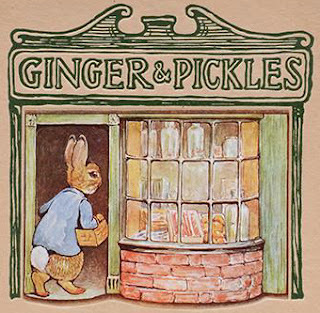
So for this post, I thought I’d ask some (fantastic!) picture book makers who are successful virtual-shop-owners for their insights into running an online illustrator shop.
I asked them how their shop got started, how they manage time spent running their shop, whether they’ve had any surprise best-sellers, and if they have any DOs or DON’Ts for those thinking about having a shop.
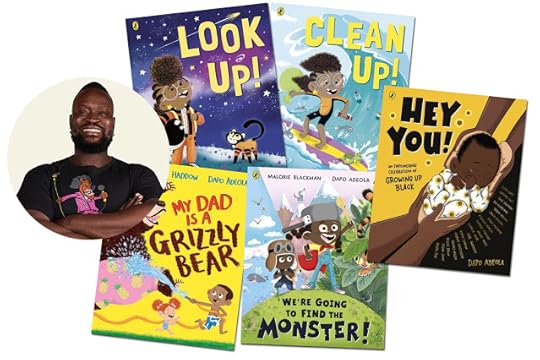
Dapo Adeola is the wonderful illustrator of Look Up (winner of the Waterstones picture book prize 2020) and Clean Up (with Nathan Bryon) and of the fabulous We're Going to Find a Monster (written by Malorie Blackman), and is Writer-Illustrator in residence at Booktrust.
We were both on the panel at the SCWBII Picture Book Weekend in September, when Dapo described how his shop had been amazingly successful – which is what sparked this investigation, really.
 From 'Look Up' by Dapo Adeola and Nathan Bryon
From 'Look Up' by Dapo Adeola and Nathan BryonDapo says “My shop got started back in 2013. It just made sense to have somewhere people can easily buy things from me and BigCartel was a simple choice because of how easy it is to use. Other platforms were a tad too complicated for what I needed at the time.”
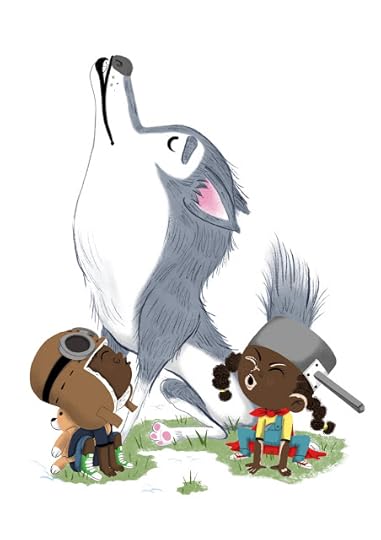 Song of the Wild print from Dapo's shop
Song of the Wild print from Dapo's shopAbout managing time spent on the shop, Dapo comments: “Because the shop isn’t my main source of income, I only open it once every other month for a week or so. That’s enough time for folks to place their orders and once it’s closed I then have time to process and ship orders undisturbed. This has had the bonus effect of creating a buzz of exclusivity around my Merch as it’s not available all year round.
 Dapo's BLM print
Dapo's BLM print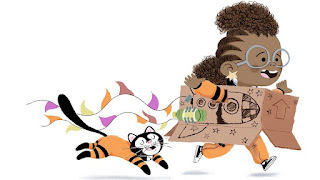 RocketMy best seller wasn’t a surprise as it somewhat capitalised on what was happening in the world at the time. I made a BLM print to raise money for various charities in 2020. I raised over £10K in less than a week. Aside from that, anything Look Up/Rocket related tends to sell very very well.”
RocketMy best seller wasn’t a surprise as it somewhat capitalised on what was happening in the world at the time. I made a BLM print to raise money for various charities in 2020. I raised over £10K in less than a week. Aside from that, anything Look Up/Rocket related tends to sell very very well.” (Rocket is the space-obsessed lovable main character in Look Up.)
 Clean Up Gift Bundle from Dapo's shop
Clean Up Gift Bundle from Dapo's shop Sarah McIntyre is the author/illustrator of many beautiful and hilarious picture books, and one half of the remarkable double act that is Reeves and McIntyre. The books of this extraordinary duo include Oliver and the Seawigs and Cakes in Space, and more recently The Legend of Kevin (the roly poly flying pony.)
Sarah McIntyre is the author/illustrator of many beautiful and hilarious picture books, and one half of the remarkable double act that is Reeves and McIntyre. The books of this extraordinary duo include Oliver and the Seawigs and Cakes in Space, and more recently The Legend of Kevin (the roly poly flying pony.)
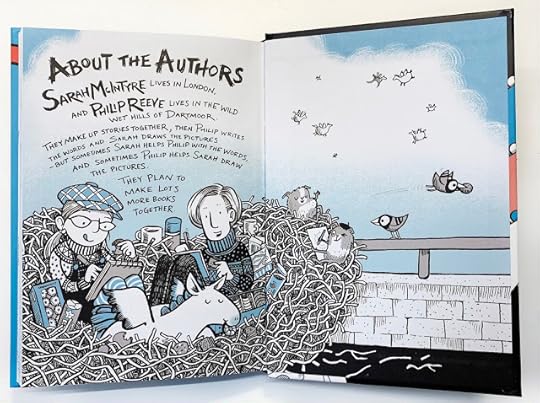
In lockdown, Kevin went on his own bookshop tour of the UK. Here are some of Sarah's Kevin Visit pictures, which are lovely bookshop portraits.
 Kevin visits Max Minerva's Bookshop
Kevin visits Max Minerva's Bookshop Kevin visits the Alligator's Mouth Bookshop
Kevin visits the Alligator's Mouth BookshopSarah’s shop also started in lockdown. She says: “I had an unexpected gap in my book schedule when a painting sabbatical to Nepal that I'd planned fell through. I started painting standalone pictures and selling them on Twitter. But when I started printing the paintings up as cards and prints, I could see I needed a more orderly way of taking people's payment details and keeping records. I went with Big Cartel because the system's very clean and straightforward; I started with a free account, then went to a paid account when I had more items to sell.”
 One of Sarah's Adventure Mice postcards
One of Sarah's Adventure Mice postcardsHow does Sarah manage time spent running the shop?
She says: “It's tricky, I had to close the shop when I got caught up in book deadlines. My husband Stuart was helping me run it on Fridays, the day we'd send out shipments, but I was hand-addressing envelopes and that took a lot of time. We recently opened for one pre-Christmas week and sold out of all the Christmas cards very quickly. The shop's closed for now, but we're hoping to reopen it in the spring and possibly expand it.”
 Sarah's surprise best seller
Sarah's surprise best sellerSarah’s surprise best seller was also a topical image-of-the-moment: “When there was that stuck container ship in the Suez, I painted a tiny version of it with mice, on a container ship full of cheese. I guess it was just very timely!”

Chris Mould is the awesome illustrator of The Iron Man and Animal Farm, and also Matt Haig's Christmas books, The Truth Pixie, and much more. On Twitter I've noticed Chris seems to have supernatural speed-painting powers, with the ability to produce landscapes out of nowhere.
 Chris at work on an Iron Man mural up in a cherrypicker...
Chris at work on an Iron Man mural up in a cherrypicker...I’d also noticed Chris’s shop popping up on Twitter.
How did it get started?
Chris: “Our youngest daughter actually set up the Etsy account. I’d wanted to try some sort of retailing option and wasn’t sure how to get started and so she did it one day in between doing other things. She’s very clever, I’m lucky. I believe it’s relatively easy, though. It’s definitely easy to manage once it’s up and running."
 The Kiss - print from Chris's shop
The Kiss - print from Chris's shop"Adding new listings, dispatching sales etc. is all very easy and the accounting is simple and pain free. They pay once a week into your account and they take a minimal amount from you. My wife works for me now. It’s made life easier for both of us. She does admin, accounting, manages most of my schools events and spends a lot of her time focussing on the shop, so I’m lucky I don’t have to think about finding the time for it. Although I do produce a lot of work specifically for the shop, when I can."
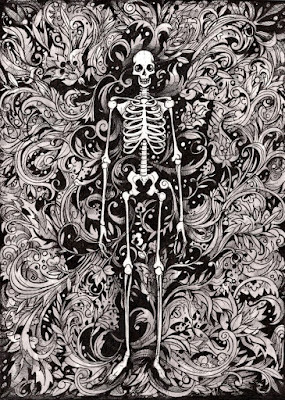 Skeletal Decor - from Chris's shop
Skeletal Decor - from Chris's shopAny bestsellers?
Chris: "I wouldn’t say I have any surprise best sellers but I think it’s worth saying that it’s definitely unpredictable. You can never guess how it will go and what people will like the most. I try to get a feel from social media if I’m going to do a new print or buy in and sell a certain book, but you can never really tell what will be popular.”
 From Chris's shop: Dreams of Dickens
From Chris's shop: Dreams of DickensAnd now for our Illustrator-Shop-owners’ DOs and DON’Ts – what to spend time on, and what to avoid.
 From The Iron Man illustrated by Chris Mould
From The Iron Man illustrated by Chris MouldFrom Chris: “DO…get yourself prepared for what you’ll need for the whole process of selling. It’s one thing sussing out Etsy software and getting to grips with adding all your sales items. But if you’re not prepared with things like bubble wrap, card, the correct envelopes, packaging, etc. you’ll find yourself in a spin. Especially if you suddenly find you’re selling more than you thought you would. It can be very time consuming.
DO…think about and look after your customers. People often come back to us and that’s a great compliment. And we’ve met so many lovely people online and in real life, through the shop. It can be very fulfilling in that way.
And … DON’T… plan to sell anything that means you’re spending an absolute fortune and unlikely to see any reasonable return on. For example, if you decided on T shirts and went out and had a design printed on every size available, you’d probably end up with boxes full of certain sizes hanging around forever.
DON’T…trip yourself up by ordering anything that might cause you storage problems. For example something like large sheets of gift wrap that need to be kept flat (unless you know you have the space and correct conditions for it).
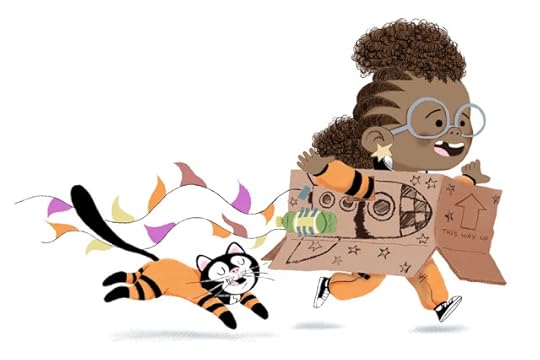 Rocket by Dapo Adeola
Rocket by Dapo AdeolaFrom Dapo: “DON’T try to pander to people if you can avoid it. It’s a slippery slope to producing work you might not enjoy. Be realistic about whether this counts as a main source of income or not and act accordingly.
DO take notes on what other artists are doing with their Merch (merchandise). This has helped me know what bits of my work translate well into Merch and which bits don’t. As a rule I don’t create “for” the shop, I only make Merch out of work I’m already doing for my books. That way I’m not working two jobs unknowingly.”
 From Don't Call Me Grumpycorn by Sarah McIntyre
From Don't Call Me Grumpycorn by Sarah McIntyreAnd from Sarah: “Be very careful about selling to Europe right now; if you do, put a warning to potential buyers. I notice that, post-Brexit, my customers are now getting hit with big customs charges at their end. And be careful about not undercharging for postage; you'd be surprised how much it costs to send a print to the USA.”
So there we have it – consider starting small. Assemble all the kit you'll need - especially for packaging. Choose your online platform. Maybe feel free to respond to current trends and events - if there's an opportunity. And if you can, have a partner who can help!
Thank you all to all three brilliant picture book makers for their insights and super-practical advice.
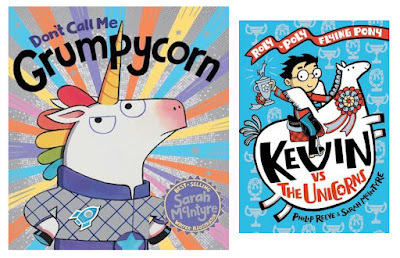 Sarah’s latest books are the colourful space adventure Don't Call me Grumpycorn and more unicorn fun in Kevin vs The Unicorns. Sarah’s shop is closed till spring at the moment, but can usually be found at: https://sarahmcintyre.bigcartel.com
Sarah’s latest books are the colourful space adventure Don't Call me Grumpycorn and more unicorn fun in Kevin vs The Unicorns. Sarah’s shop is closed till spring at the moment, but can usually be found at: https://sarahmcintyre.bigcartel.com
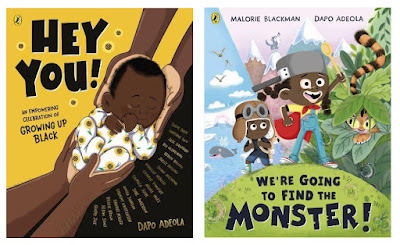 Hey You! is Dapo's debut book as author, and look out for the wonderful We're Going To Find The Monster! with Malorie Blackman. You can find Dapo’s shop at: https://dapsdraws.bigcartel.com/
Hey You! is Dapo's debut book as author, and look out for the wonderful We're Going To Find The Monster! with Malorie Blackman. You can find Dapo’s shop at: https://dapsdraws.bigcartel.com/
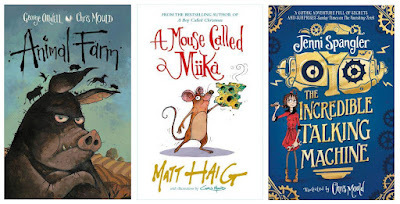 Don’t miss Chris’s version of Animal Farm, just fantastically illustrated. Visit Chris’s shop on Etsy at:https://www.etsy.com/uk/shop/ChrisMouldArtwork
Don’t miss Chris’s version of Animal Farm, just fantastically illustrated. Visit Chris’s shop on Etsy at:https://www.etsy.com/uk/shop/ChrisMouldArtwork
Mini's latest published book-involvement is The Book of Not Entirely Useful Advice, with AF Harrold. Her BlogSite is at Sketching Weakly.
